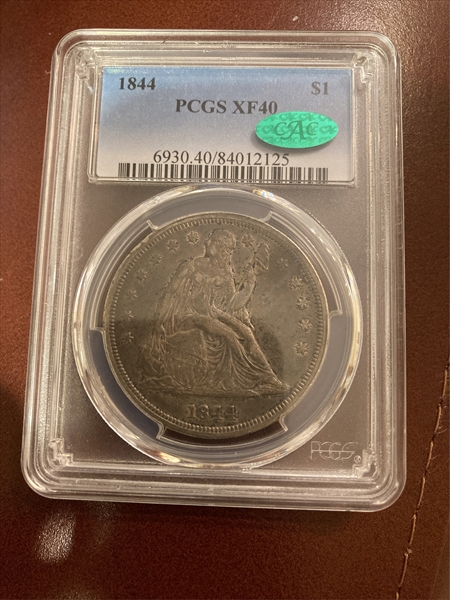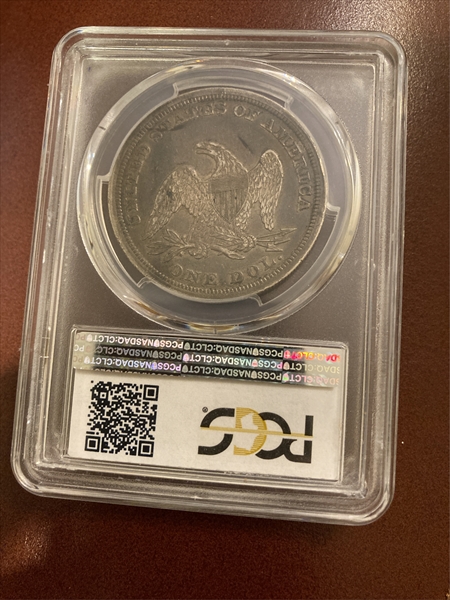1844 $1 XF40 认证号84012125, PCGS号6930
拥有者评论
Cac
专家评论
Q. David Bowers
The following narrative, with minor editing, is from my "Silver Dollars & Trade Dollars of the United States: A Complete Encyclopedia" (Wolfeboro, NH: Bowers and Merena Galleries, Inc., 1993).Coinage Context
Inactivity: The year 1844 was notable for the first of low-mintage silver dollars of this design. Scant supplies of silver bullion continued to be one of the main problems facing the mint, and the situation was not made easier by the fact that many United States silver coins were shipped to Europe and Asia in payment for import transactions. Only one delivery of silver dollars was made this year; that of 20,000 pieces on December 31st. The China trade in particular demanded silver in later years, although as certain ports of China were opened for the first time to Westerners in 1842, it probably is the case that by 1844 relatively little trade had yet developed between the United States and that country.
Numismatic Information
Four stripes: Circulation strikes of the year 1844 have four tiny vertical stripes composing each large vertical stripe on the obverse shield, whereas all other circulation strikes in the Liberty Seated series from 1840 to 1873 have just three stripes, as do Proofs of all years (including Proofs of 1844). The fourth or extra stripe, to the right side of the normal three, is in all cases more lightly defined than the other three and is somewhat irregular. The feature is considered to be a doubled die. A few other elements of die doubling are present, including a doubling of the pointed top to the shield and the presence of three border lines (instead of the normal two) on the right edge of the shield. Apparently, the feature of four elements to each stripe is unique in the series.
In articles in The Gobrecht Journal this aspect of circulation strike 1844 dollars has been called "quad stripes." Outside of the circle of the Liberty Seated Collectors Club this has not been extensively publicized, although it is becoming better known as copies of Walter Breen's Complete Encyclopedia of U.S. and Colonial Coins reach an ever wider circle of readers, for this book devoted about a quarter page (p. 437) to an illustration and description of it.
Circulated grades: Although the mintage of the 1844 is an enticingly low 20,000 pieces, examples of this date in circulated grades appear on the market with regularity. Although numismatically scarce, the 1844 is not a rarity in worn grades. I believe that bank tellers and others recognized the desirability of the 1844 and certain other low-mintage issues (such as 1845 and 1848 and the Carson City coins) and picked them out of circulation beginning in the 1890s and continuing through the first decade or so of the twentieth century. Contemporary coin premium guides confirm this.
Mint State grades: In Mint State the low-mintage 1844 dollar is very rare. In MS-63 or better condition the date is an extreme rarity. What few Mint State coins I have seen have all been very frosty, sometimes with prooflike reverse fields. As time goes on and as the quad stripe feature of the 1844 circulation strike dollars becomes. more widely known among numismatists, the 1844•will probably take on special meaning to collectors and become even more desired than it is already. By any standard, a Mint State 1844 dollar is a desirable coin to own.
In 1982, Bruce Amspacher stated that he knew of only one that could be called MS-65, a grade that today would be equal to MS-63 or so. This coin was via a second-hand report from another dealer, Robert Emmer.(Article, "Liberty Seated Dollars," in the Monthly Summary, Coin Dealer Newsletter, July-August, 1982.)
Varieties
Circulation strikes:
1. "Quad Stripes" issue: Breen-5431. The 20,000 circulation strikes produced may have been made from the same die, with "quad stripes" to the obverse shield, the result of die doubling. The reverse, called the "armpit variety" by Breen, has many crisscross die file marks between the eagle's wings and body, particularly evident beneath the wing to the observer's left. In the shield on the eagle's breast two (out of three) left most vertical stripe elements in the leftmost stripe extend into the horizontal stripe just above (this is almost subliminal but can be seen under magnification). An extraneous loop, from the upper loop of the digit 8, can be seen in a drapery fold above the base of Miss Liberty, above the space between the digits 8 and 4. Some have a clash mark in the right obverse field near Miss Liberty's arm; the transferred image of an outline area of the eagle on the reverse (similar in position and appearance to a clash mark seen on 1851 original dollars). This die pair is the only one seen.
2. Triple Stripes: (Unconfirmed.) In a letter to the editor of The Gobrecht Journal, November 1977, Ron Severa stated that he had examined approximately two dozen 1844 dollars, and just two of these were not of the quad stripes variety, both of which graded less than Fine. Other than this mention, I have not heard of this variety. Walter H. Breen is not aware of it either. More information is needed. Are these worn-down Proofs?
Circulation strike mintage: 20,000; Delivery figures by day:(It was normal practice during this era to deliver coins on the last working day of the month. However, there were exceptions.) December 31: 20,000.
Estimated quantity melted: Unknown
Characteristics of striking: Usually well struck with smooth surfaces
Known hoards of Mint State coins: None
Commentary
The circulation strike dollars of this date are unique in the series in that each stripe in the obverse shield is composed of four tiny elements, "quad stripes," instead of the normal three.
Additional Information
Silver Coinage
Foreign silver and gold coins formed the bulk of circulating specie of these metals, and in some areas, especially in the southern part of the Mississippi Valley, United States coins were rarely seen, except, perhaps, for some few pieces from the New Orleans Mint. In Louisiana, most reckoning was still done in terms of Spanish (i.e., mostly Mexican) dollars and fractions.
In 1844 the government began in earnest recoining foreign coins acquired in government transactions. Many if not most of such pieces in the silver series were lighter in weight than the U.S. Mint coins that replaced them, a situation which caused a lessening of the total number of silver coins in circulation."
The earlier law was ambiguous on the legality of Spanish-American coins weighing less than 415 grains, and it is doubtful if fractions of the eight-real coins had legal tender status. However, the Mint took such pieces in at a loss to the American public, and recoined half dimes, dimes, quarter dollars, half dollars, and dollars from them. Carothers notes the following:
"The [Spanish-American] fractional coins were commonly accepted at values of 50, 25, 12-1/2, and 6-1/4 cents. In cities where the decimal system was making progress, the fractional remainders were often dropped, the real passing for 12 cents, the medio for 6 cents. The great depreciation in weight of the foreign coins and the losses on recoinage were beginning to cause disturbances. The general public was not concerned so long as the coins could be passed on to any storekeeper. The merchant in turn could adjust prices to the situation; he could deposit the coins in a bank. But the banks could not ignore the deficiency and they could not force them on customers who asked for United States coins. They had to take the old coins to the Treasury for recoinage.
"As early as 1832 banks in Philadelphia protested the deposit of 'large amounts of [Mexican] silver dollars by tale' [i.e., by count at $1 each]. No settled policy was adopted until 1843, in which year the New York Bank established a scale of values. The double real, real, and media were not to be taken at values higher than 23, 10, and 5 cents respectively. The post office had adopted the same valuations, despite public protest. By 1848 the New York ratings had been adopted by banks and post offices the country over. The ratings permitted the banks to recoin most of the foreign receipts without loss and enable the Treasury to carry out an extensive recoinage. But this also gave rise to a peculiar situation in which general currency was received at one value in ordinary transactions and at another in dealings with the Post Office ....
"The circulation of two types of silver coins-United States as well as foreign issues-was beginning to cause annoyance in business. Eventually special ratings for Spanish coins were five cents, 10 cents, and 20 cents, but in some transactions smaller pieces were valued at 12-1/2 cents and 6-1/2 cents and 12 and 6 cents. Making change was a matter that involved calculation. In the South and West the careless monetary habits of the people made copper coins superfluous. The purchaser of a half bit's worth of tobacco paid for it with a bit and should have received a half bit or 6-1/4 cents in change in the West, but he accepted a half dime if the storekeeper offered it. Throughout the South and the West the dime and half dime were commonly accepted as the change equivalence of the real and medio. In fact the dime was what was widely known as the "short bit." The storekeeper who paid out 10 dimes when he should have given out 10 reals made a profit of 25 cents. The people were systematically victimized. The practice became so firmly entrenched that Congress was trying to stop it as late as 1875 .... (However, Senator John P. Jones's proposed solution in 1875, the 20¢ piece, was a failure, being too close to the quarter in design and size. Jones's real aim was to create an additional market for mine owners in an era when silver ruled the politics of the American West.)
"In 1844 the legal ratio turned the tide of silver movements against the country. By now the devaluation of silver caught up with the system, and from this year on the exports to England exceeded the imports from Mexico. [Large shipments of gold from England to the United States had serious negative effects on the British gold reserves.]"
PCGS #
6930
设计师
Christian Gobrecht
边缘
Reeded
直径
38.10 毫米
重量
26.73 克
铸币数量
20000
金属成分
90% Silver, 10% Copper
更高评级数量
227
评级较低的钱币数量
79
地区
The United States of America
价格指南
PCGS 数量报告
拍卖 - PCGS 评级的
拍卖 - NGC 评级的
稀有性和存量估计 了解更多
| 所有评级 | 1750 |
| 60或以上 | 60 |
| 65或以上 | 1 |
| 所有评级 | R-4.7 |
| 60或以上 | R-8.4 |
| 65或以上 | R-10.0 |
| 所有评级 | 17 / 30 TIE |
| 60或以上 | 13 / 30 TIE |
| 65或以上 | 1 / 30 TIE |
| 所有评级 | 27 / 45 TIE |
| 60或以上 | 20 / 45 TIE |
| 65或以上 | 1 / 45 TIE |


























